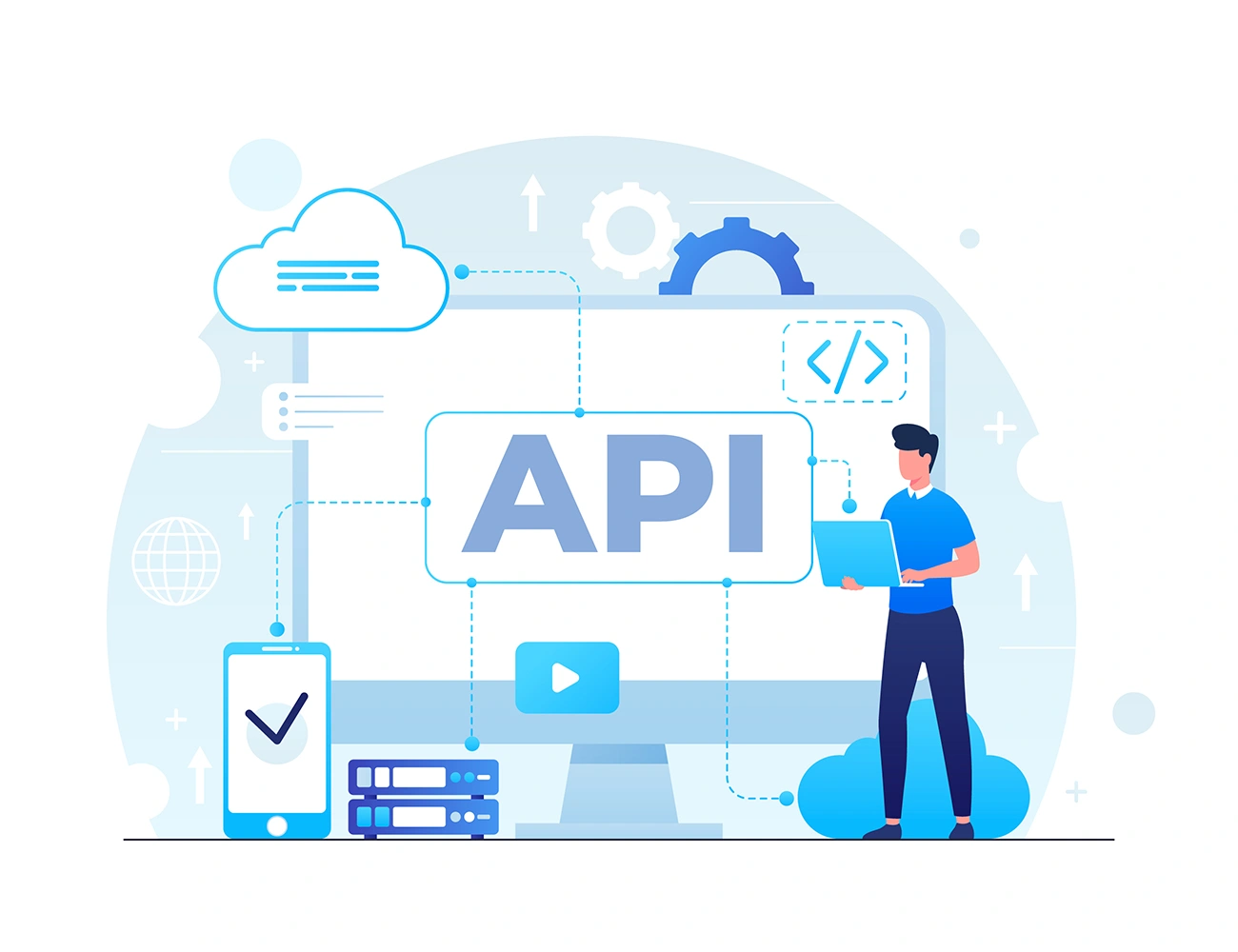In the fast-paced world of digital innovation, API hosting plays a pivotal role in enabling seamless data communication between different software applications and services. Whether you’re a developer, a business owner, or simply someone curious about the world of APIs, understanding what API hosting is and its significance is essential. In this comprehensive guide, we’ll delve into the depths of API hosting, discuss the best API hosting providers, and explore the nuances of this technology. From “What is API hosting?” to the pros and cons, we’ve got it all covered.

Visual Representation of API Hosting Architecture
What is API Hosting?
API hosting, short for Application Programming Interface hosting, is the practice of making APIs accessible and available on the internet, whereas File API hosting simplifies the storage and sharing of files online, offering an efficient solution for data management and accessibility. An API is essentially a set of rules and protocols that allows one software application to interact with another, enabling them to share data and functionality. API hosting providers facilitate the deployment and management of these APIs, making them accessible to developers and businesses worldwide. This practice is crucial in the digital age, as it empowers seamless integration, enabling applications to communicate effectively and share resources, ultimately enhancing user experiences and driving innovation in software development.
Why Take API Hosting?
API hosting is a pivotal element in contemporary software development and digital connectivity. It empowers businesses to expand their application functionality, elevate user experiences, and seamlessly integrate with external services. Through API hosting, organizations open the door to a multitude of opportunities, ranging from real-time data sharing to facilitating third-party integrations. This technology forms the backbone of modern digital innovation, enabling companies to adapt, evolve, and remain competitive in an ever-changing technological landscape.
💡 Did you know? Some of the best web hosting services in 2025 also provide robust and scalable infrastructure ideal for API hosting.
How API Hosting Works?
API hosting works by providing a secure and scalable environment for hosting APIs. When a developer or a service provider hosts an API, it becomes accessible over the internet. Other applications can then send requests to this API, and the hosting infrastructure processes these requests, executes the required actions, and returns the desired data. This process enables smooth communication between different software components.
How do I host an API service?
Hosting an API service involves several steps, including selecting an API hosting provider, defining the API endpoints, setting up security measures, and configuring the hosting environment. Each hosting provider may have its own set of instructions and tools to assist with API deployment. Popular providers like Hostinger, Bluehost, Kinsta, and WP Engine offer user-friendly interfaces to help you get started.
What are the 4 Types of API?
Open APIs
Open APIs, also known as public APIs, are a beacon of innovation and collaboration in the digital realm. These interfaces are designed to be accessible to external developers, fostering a spirit of openness and cooperation in the tech ecosystem.
They provide a gateway to valuable data and services, allowing third-party developers to create applications that can interact with and extend the functionality of a specific platform or service. For instance, social media platforms like Facebook and Twitter offer open APIs that let developers build apps capable of posting updates or accessing user data—leading to rich integrations and enhanced user experiences.
However, while open APIs open many doors, they also bring challenges—particularly in balancing openness with security and privacy. This is especially crucial in cloud-connected environments where cloud computing plays a central role in deployment and scalability.
Partner APIs
Partner APIs, sometimes referred to as private APIs, serve as secure bridges for collaboration and data sharing between trusted business entities. Unlike open APIs, these are only shared with approved partners, offering exclusivity and privacy.
Businesses use partner APIs to streamline services between platforms, whether it’s syncing order systems between a vendor and distributor or enabling secure payment gateways. Establishing proper documentation, access controls, and usage monitoring is key to maintaining security and efficiency in these collaborations.
Internal APIs
Internal APIs are built for internal use within an organization. They allow various departments and applications to communicate effectively by integrating backend systems, databases, and services.
For example, a sales team’s CRM can use internal APIs to fetch data from an ERP system, helping departments work with updated information in real time. These APIs aren’t visible to the public, but they form the backbone of operational automation and digital transformation efforts.
💡 Beginner’s Tip: If you’re new to hosting APIs and looking for a free or budget-friendly solution, start by checking out these free web hosting providers that support basic API deployments.
Composite APIs
Composite APIs combine multiple API calls into a single request, simplifying complex operations. This is especially useful in scenarios where an application needs to pull data from various sources and present it together.
A practical example is a weather app that pulls data from meteorological services, traffic reports, and maps—delivering it as one comprehensive report to the user. Composite APIs reduce the number of server round-trips and boost performance for front-end applications.
What is API Design and Its Approaches
API Design refers to the process of creating and defining an API so that it is efficient, easy to use, and serves its intended purpose effectively. Good API design is crucial for promoting developer adoption, ensuring stability, and fostering a positive user experience.
There are several approaches to API design, and the choice of approach depends on the specific requirements and goals of the API. Here are some common approaches:
RESTful API Design
Representational State Transfer (REST) is an architectural style that uses a stateless, client-server communication model. RESTful APIs are designed around resources and use HTTP methods (GET, POST, PUT, DELETE) to perform CRUD operations. They are known for their simplicity and scalability.
SOAP API Design
Simple Object Access Protocol (SOAP) is a protocol for structuring messages in web services. SOAP APIs follow strict standards, use XML-based messaging, and provide built-in security features. They’re often found in enterprise-level applications.
GraphQL API Design
GraphQL is a query language that allows clients to request exactly the data they need. It enhances flexibility and efficiency by enabling precise data queries and minimizing over-fetching or under-fetching of data.
RPC (Remote Procedure Call) API Design
RPC APIs let clients invoke functions on remote servers as if they were local methods. They are commonly used in microservices architectures and distributed systems to improve modularity and communication.
💡 Highlight: When choosing an API design, consider the infrastructure where your API will live. Explore Tech Hosting solutions for optimal developer environments. You can also review trusted API design principles from the Swagger API Design Guide.
Hypermedia API Design
Hypermedia APIs, like HATEOAS (Hypermedia as the Engine of Application State), include embedded links and actions in the API responses that guide client interactions. This promotes self-discovery and reduces the need for heavy documentation.
Event-Driven API Design
Event-driven APIs allow applications to respond asynchronously to events or messages. These are popular in real-time systems, IoT environments, and microservices, allowing loosely coupled components to interact efficiently.
Each API design approach has its own advantages and limitations. The best choice depends on your project’s goals, user expectations, and technical landscape. Following key principles like simplicity, consistency, versioning, and robust documentation is essential to building successful APIs.
Pros and Cons of API Hosting
| Pros | Cons |
|---|---|
| Enhanced Connectivity: API hosting facilitates seamless integration between applications, leading to enhanced connectivity. | Security Concerns: APIs can be vulnerable to security threats if not properly protected. |
| Scalability: Hosting providers offer scalable solutions to accommodate growing traffic and usage. | Maintenance Challenges: Regular maintenance and updates are necessary to ensure API functionality. |
| Global Reach: APIs hosted on the internet can be accessed globally, expanding your reach. | Costs: Depending on the hosting provider and usage, hosting APIs can incur costs. |
How Secure Is API Hosting?
API hosting security is a paramount concern. Top hosting providers implement robust security measures, including encryption, authentication, and authorization, to protect APIs and sensitive data. Regular security audits and updates are essential to maintain a secure hosting environment.
Affiliate Hosting Providers That Support API Hosting
In the evolving world of modern development, API hosting has become essential for businesses that require scalable, connected, and modular systems. Whether you’re building a SaaS application, integrating third-party services, or enabling mobile apps to communicate with your backend, reliable API hosting is key. Fortunately, many of the affiliate hosting providers we’ve partnered with offer robust API hosting capabilities, ensuring performance, uptime, and developer-friendly environments.
 Cloudways offers powerful managed cloud hosting tailored for API developers, supporting PHP, Node.js, Python, and more.
Cloudways offers powerful managed cloud hosting tailored for API developers, supporting PHP, Node.js, Python, and more.
 ChemiCloud supports custom API deployment on LiteSpeed servers using PHP, Node.js, and Python, perfect for startups and agencies.
ChemiCloud supports custom API deployment on LiteSpeed servers using PHP, Node.js, and Python, perfect for startups and agencies.
 HostArmada provides scalable API environments supporting Express.js, Laravel, and Flask with SSH, Git, and CDN support.
HostArmada provides scalable API environments supporting Express.js, Laravel, and Flask with SSH, Git, and CDN support.
 InterServer delivers customizable VPS hosting for any backend tech stack like Django, Node.js, and REST APIs with root access.
InterServer delivers customizable VPS hosting for any backend tech stack like Django, Node.js, and REST APIs with root access.
 GreenGeeks offers eco-friendly hosting that supports API stacks like Python, PHP, and Node.js with built-in developer tools.
GreenGeeks offers eco-friendly hosting that supports API stacks like Python, PHP, and Node.js with built-in developer tools.
 Hostwinds is ideal for scalable REST or GraphQL APIs on VPS with full root access and SSD-powered servers.
Hostwinds is ideal for scalable REST or GraphQL APIs on VPS with full root access and SSD-powered servers.
 AccuWebHosting offers Windows & Linux VPS, Docker support, and custom environments tailored for SOAP & REST APIs.
AccuWebHosting offers Windows & Linux VPS, Docker support, and custom environments tailored for SOAP & REST APIs.
 Kinsta offers powerful app hosting for modern frameworks like Node.js, Laravel, and Python-based APIs via their custom dashboard.
Kinsta offers powerful app hosting for modern frameworks like Node.js, Laravel, and Python-based APIs via their custom dashboard.
These hosting partners not only bring high performance and scalability but also provide the API tools, frameworks, and server access needed for developers and businesses to launch connected, fast, and secure applications worldwide.
Conclusion
API hosting is the backbone of modern digital connectivity, enabling businesses and developers to harness the power of data integration and external services. It provides a platform for developers to deploy and manage web-based APIs, enabling seamless communication between software applications and services over the internet.
It empowers innovation, streamlines processes, and enhances user experiences. To succeed in the digital landscape, choosing the right API hosting provider is crucial, and understanding the pros and cons ensures you make informed decisions.
As technology continues to evolve, API hosting will remain a cornerstone of digital transformation. For developers looking to explore REST-based hosting features, Firebase’s REST API documentation is a great external reference that demonstrates how modern API infrastructure is managed in real-world environments.








